The safe handling of microwave capacitors is of utmost importance due to the potential risk of electric shock. One crucial aspect of working with microwave capacitors is understanding how long it takes for them to discharge.
Microwave capacitors store electrical energy even after the power is disconnected, and a thorough understanding of the discharge time helps ensure the safety of technicians and individuals working on microwave components.
In this article, we will delve into the factors that affect the discharge time of microwave capacitors, explore approximate discharge times, and provide insights on how to safely discharge microwave capacitors before performing any maintenance or repairs.
What Is a Microwave Capacitor?

Unlike regular capacitors, microwave capacitors are engineered to withstand the high voltage and current requirements of microwave ovens [1].
Microwave capacitors are typically composed of two conductive plates separated by an insulating material, known as a dielectric. The conductive plates are usually made of metal, while the dielectric can be constructed from materials such as ceramic, mica, or tantalum. This configuration creates an electric field between the plates when voltage is applied.
During operation, the microwave capacitor charges up by accumulating electrical energy from the power source. Once fully charged, it discharges the stored energy in a rapid burst. This sudden release of electrical energy creates the high-frequency microwaves that interact with water molecules in food, causing them to vibrate and generate heat.
Symptoms Of A Bad Microwave Capacitor:
- Microwave not heating;
- Microwave not starting ;
- Sparking or arcing inside the microwave;
- Loud buzzing or humming sound;
- The microwave shuts off suddenly;
Do You Need to Discharge Microwave Capacitors?
It is essential to discharge microwave capacitors before attempting any repair or maintenance work. Microwave capacitors can retain a significant amount of electrical charge, even when the microwave is unplugged. Failing to discharge them properly can result in severe electrical shocks or injuries.
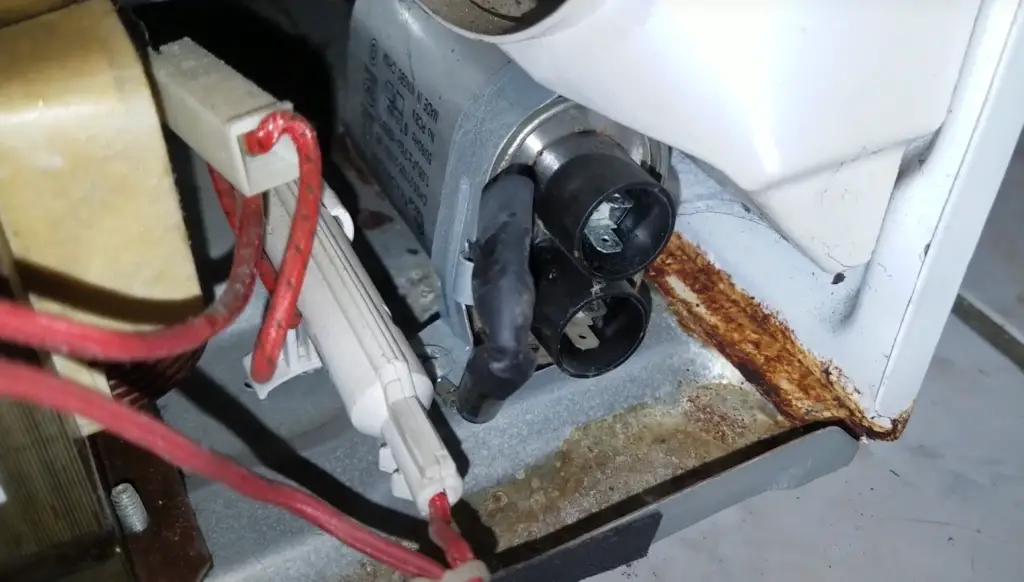
To discharge a microwave capacitor safely, follow these steps:
- Unplug the microwave: Before starting any work, ensure that the microwave is unplugged from the power source to eliminate the risk of electric shock;
- Locate the capacitor: The capacitor is usually located near the magnetron or power supply area. Refer to the microwave’s user manual or seek professional guidance if needed;
- Use a discharge tool: To discharge the capacitor, use a discharge tool specifically designed for this purpose. These tools are typically insulated and have a resistor to safely dissipate the electrical charge. Carefully follow the instructions provided with the discharge tool;
- Confirm the discharge: After using the discharge tool, use a multimeter to verify that the capacitor is fully discharged. This step ensures your safety when working on the microwave [2];
How Do You Discharge a Microwave Capacitor:
Get the Things You Will Need
Before you begin the process, gather the necessary tools and equipment to ensure a smooth and safe procedure. You will need a set of insulated gloves, a well-insulated screwdriver with a long handle, a discharge resistor (such as a high-wattage resistor), and a voltmeter. These tools will help protect you from electrical shock and assist in safely discharging the capacitor.
Unplug the Microwave
To ensure your safety, always start by unplugging the microwave from the power source. This step is crucial as it cuts off the electrical supply to the appliance, minimizing the risk of electric shock during the discharging process.
Remove the Plate and Glide Roller
Next, remove the glass plate and glide roller from inside the microwave. These components can usually be easily lifted out or detached, depending on the specific model of your microwave. Set them aside in a safe place to avoid any damage.
Remove the Top Grill Behind the Door
Once the plate and glide roller are removed, locate the top grill behind the microwave’s door. This grill is usually held in place by screws or clips. Use a screwdriver or your hands to carefully remove the screws or unclip the grill, exposing the internal components of the microwave.
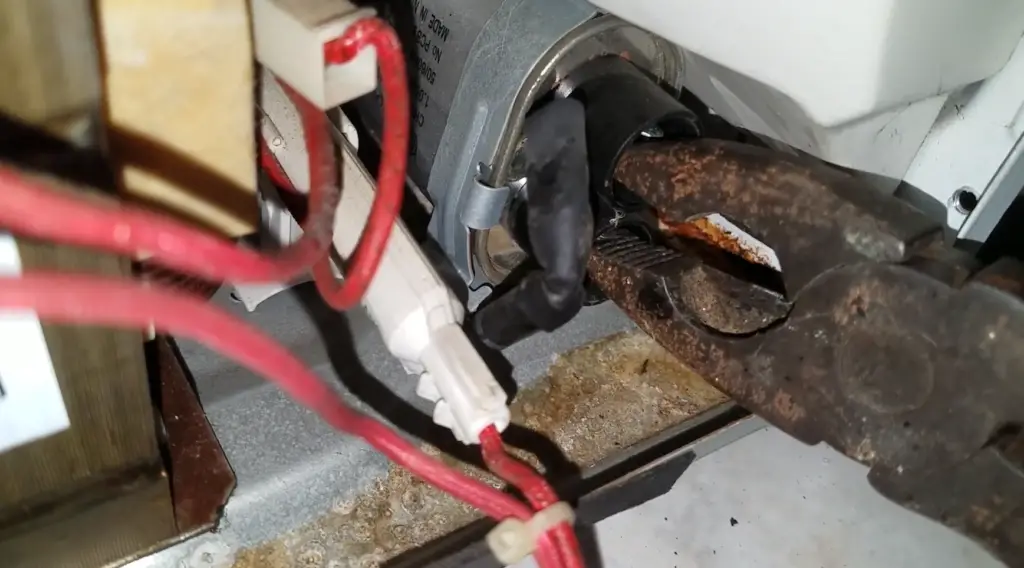
Remove the Bottom Panel
After removing the top grill, you will find the bottom panel of the microwave. Similarly, this panel is secured by screws or clips. Unscrew the screws or unclip the panel to gain access to the inner workings of the microwave.
Unwrap the Microwave Case From the Body
With the bottom panel removed, you will be able to see the microwave’s internal case. Carefully unwrap the case from the body of the microwave, exposing the electronics and components inside. Take extra caution not to damage any wires or other delicate parts during this step.
Find the Terminals and Capacitor
Now that you have uncovered the internal components, locate the terminals and capacitor. The capacitor is a cylindrical or rectangular-shaped component that stores electrical energy. It is crucial to identify the terminals correctly to ensure safe discharge.
Before proceeding with the discharge, use a voltmeter to check if any charge remains in the capacitor. Set the voltmeter to the appropriate voltage range and place the probes on the capacitor’s terminals. If the voltmeter displays a reading, there is still residual charge in the capacitor, and it must be discharged [3].
Discharging the Capacitor
To discharge the microwave capacitor safely, you need to create a low-resistance path for the stored electrical energy to dissipate.
Take the insulated screwdriver with the long handle and touch its metal end to one terminal of the capacitor. Then, carefully touch the other terminal with the metal shaft of the screwdriver. This will create a short circuit, allowing the stored charge to flow through the screwdriver and dissipate harmlessly.
For added safety, you can also use a discharge resistor. Connect one end of the resistor to one terminal of the capacitor and touch the other end to the remaining terminal. This will slowly discharge the capacitor, ensuring a controlled and safer process.
Verify Capacitor Discharge
After discharging the capacitor, use the voltmeter again to confirm that there is no residual charge. If the voltmeter shows zero voltage or near-zero readings, it indicates that the capacitor has been successfully discharged.
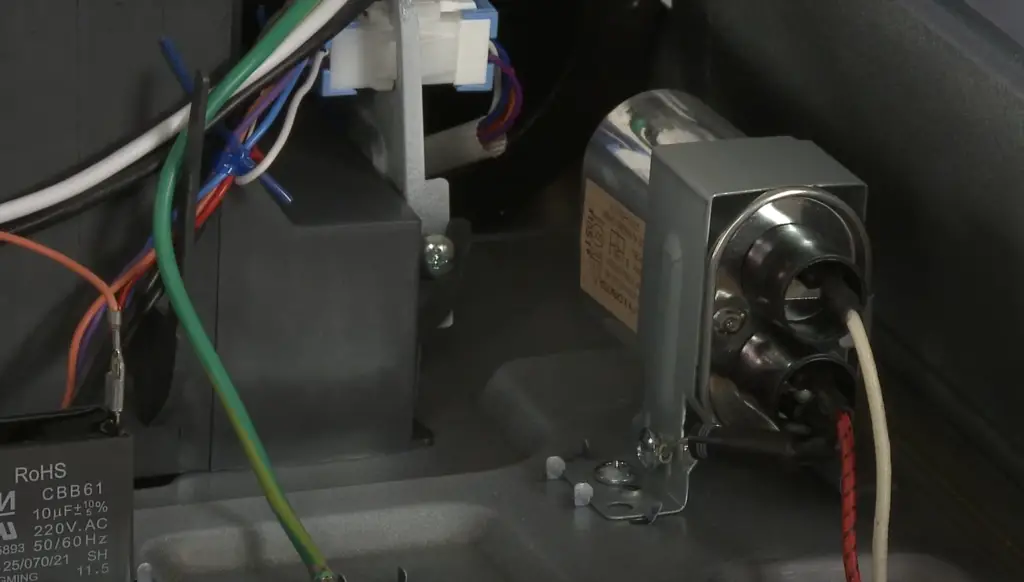
Reassemble the Microwave
Once you have confirmed that the capacitor is discharged, it is safe to reassemble the microwave. Follow the steps in reverse order, putting the case back on, reattaching the bottom panel, and securing the top grill and door.
How To Discharge A Microwave Capacitor With A Multimeter?
1. Safety First
Before attempting to discharge the capacitor, it is crucial to prioritize safety. Ensure you are wearing appropriate personal protective equipment (PPE), including insulated gloves and safety glasses. This will protect you from potential electrical shocks and other hazards.
2. Disconnect the Microwave
Start by unplugging the microwave from the power source. This step ensures that no electrical current is flowing through the appliance during the discharging process, reducing the risk of electrical shock.
3. Locate the Capacitor
To discharge the microwave capacitor, you must first locate it. The capacitor is usually located near the magnetron, which is the device responsible for generating the microwaves. However, it’s important to consult the microwave’s service manual or schematic diagram for specific instructions regarding the capacitor’s location in your model.
4. Setting Up the Multimeter
Once you have located the capacitor, set up your multimeter for measuring voltage. Ensure that the multimeter is set to the appropriate voltage range, capable of handling the high voltage typically found in microwave capacitors. The voltage range should be higher than the expected voltage stored in the capacitor.
5. Discharge the Capacitor
With the multimeter properly set up, take the multimeter’s probes and touch them to the terminals of the capacitor. Be cautious to avoid touching any metal parts of the probes, as this can create a short circuit. Hold the probes in place for a few seconds to allow the capacitor to discharge completely.
6. Verify the Discharge
After discharging the capacitor, it’s crucial to verify that it is fully discharged before proceeding with any repairs or maintenance. Use the multimeter to measure the voltage across the capacitor terminals again. If the reading shows no voltage or a very low voltage, it indicates that the capacitor is discharged and safe to handle. However, if the voltage is still high, repeat the discharging process until it reaches a safe level.
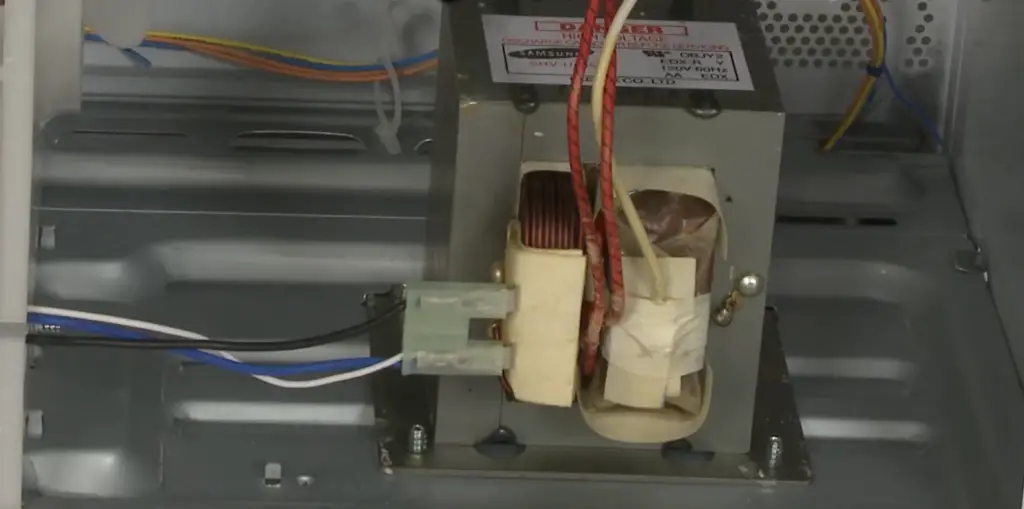
7. Safety Precautions
Even after discharging the capacitor, it’s important to handle it with care. Capacitors can still store a residual charge, so avoid touching the terminals directly. Use insulated tools or gloves when handling the capacitor to prevent accidental electrical shocks [4].
How To Discharge A Microwave Oven Capacitor?
To discharge a microwave oven capacitor, there are different methods that can be used, but here is a general process that you can follow:
- Unplug the microwave oven from the outlet to make sure it is not receiving power;
- Locate the capacitor, which is usually a cylindrical component with two metal terminals. It may be located near the magnetron;
- Wear protective gloves and use a screwdriver with an insulated handle to discharge the capacitor. Make sure the screwdriver has a flat blade and is long enough to keep your hand away from the capacitor;
- Touch the tip of the screwdriver simultaneously to both terminals of the capacitor. This will cause a spark to occur and the capacitor to discharge;
- Hold the screwdriver in place for several seconds to make sure the capacitor is fully discharged;
- Repeat the process a few times to make sure the capacitor is fully discharged;

How To Discharge A Microwave Transformer?
Discharging a microwave transformer involves discharging the high voltage capacitor as well as removing the transformer. Here are the general steps to discharge a microwave transformer:
- Unplug the microwave from the power source to ensure that it is not getting any electricity;
- Locate the high voltage capacitor and use a screwdriver with an insulated handle to discharge it, following the steps mentioned in the previous answers;
- Once the capacitor is discharged, locate the transformer, which is a heavy, square-shaped component, and remove it from the microwave. This may involve removing screws or other components that are holding it in place;
- Before handling the transformer, check it for any signs of damage or cracking, which could indicate that it is not safe to use;
- Use a multimeter to check the transformer for continuity, which will help determine if it is still functioning properly;
- If you need to replace the transformer, make sure to purchase one that is specifically designed for your model of microwave;
How To Test A Microwave Capacitor:
Disconnect the Power Source
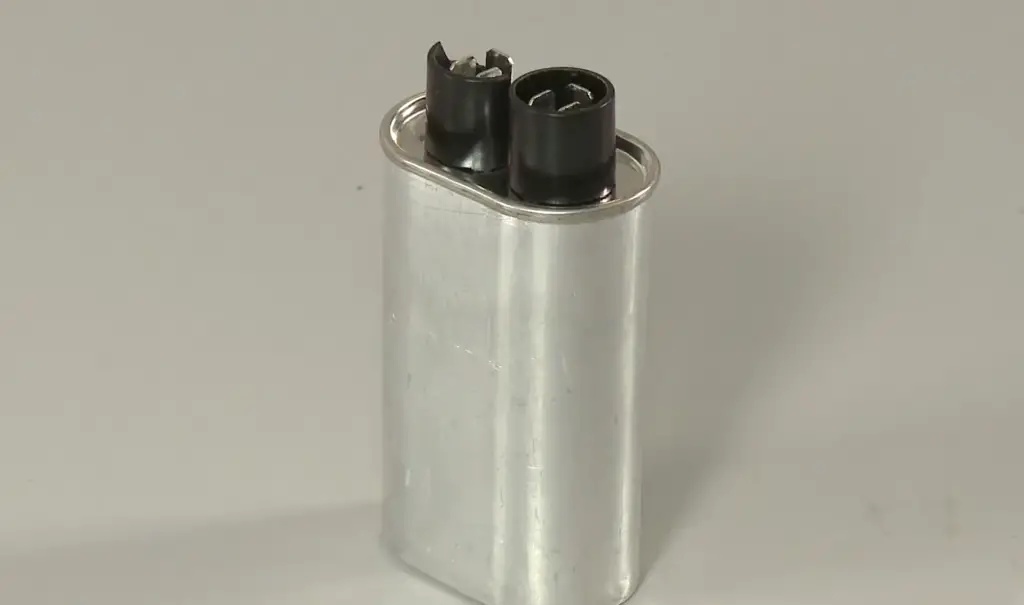
Locate the Capacitor
The capacitor in a microwave is typically found near the magnetron or on the control board. Refer to the microwave’s service manual or schematic diagram to identify the capacitor’s exact location in your model. Take note of its position for the subsequent testing steps.
Test the Capacitor for Continuity
Using a multimeter set to the continuity or resistance mode, test the microwave capacitor for continuity. Continuity refers to the uninterrupted flow of electrical current through a component. Touch the multimeter probes to the terminals of the capacitor, ensuring a good connection. If the multimeter shows continuity (a low resistance reading), it indicates that the capacitor is functioning correctly. However, if there is no continuity or a high resistance reading, the capacitor may be faulty and should be replaced.
Test the Capacitor for Capacitance
The next step is to test the capacitance of the microwave capacitor. Set the multimeter to the capacitance mode and connect the probes to the respective capacitor terminals. The multimeter will display the capacitance value. Compare this reading with the capacitor’s specified capacitance, which can be found on the component itself or in the microwave’s service manual. If the measured capacitance is significantly different from the specified value, it indicates a faulty capacitor that needs replacement.
Test the Capacitor for Leakage
Capacitor leakage can occur when the insulation inside the component breaks down, leading to a flow of current where it shouldn’t be. To test for leakage, set the multimeter to the resistance mode and connect one probe to a terminal of the capacitor. With the other probe, touch various points on the capacitor’s body. If the multimeter shows any resistance reading other than infinity, it indicates leakage. A leaking capacitor should be replaced promptly to avoid potential hazards [5].

How Long Do Microwave Capacitors Hold Charge?
1) Capacitor Size and Voltage Rating
The size and voltage rating of a microwave capacitor play a significant role in determining how long it holds a charge. Capacitors with larger capacitance values and higher voltage ratings tend to store more charge and hold it for a longer time. Higher voltage capacitors, such as those found in microwaves, are designed to hold a charge for an extended period compared to lower voltage capacitors used in other electronic devices.
2) Discharge Circuitry
Microwave capacitors are often equipped with discharge circuitry that helps to dissipate any remaining charge when the appliance is unplugged. This circuitry allows the capacitor to discharge relatively quickly and reduces the time it holds a charge. However, the effectiveness of the discharge circuitry can vary between different microwave models.
3) Temperature and Environmental Conditions
The temperature and environmental conditions can also impact how long a microwave capacitor holds a charge. Higher temperatures can cause the charge to dissipate more quickly, whereas lower temperatures can prolong the retention time. Additionally, factors such as humidity and the presence of contaminants can affect the discharge characteristics of the capacitor.
4) Capacitor Age and Condition
Over time, capacitors may deteriorate or degrade, which can affect their ability to hold a charge. Aging capacitors may exhibit higher leakage currents, leading to faster discharge rates. Therefore, the age and condition of the capacitor can influence how long it retains a charge [6].
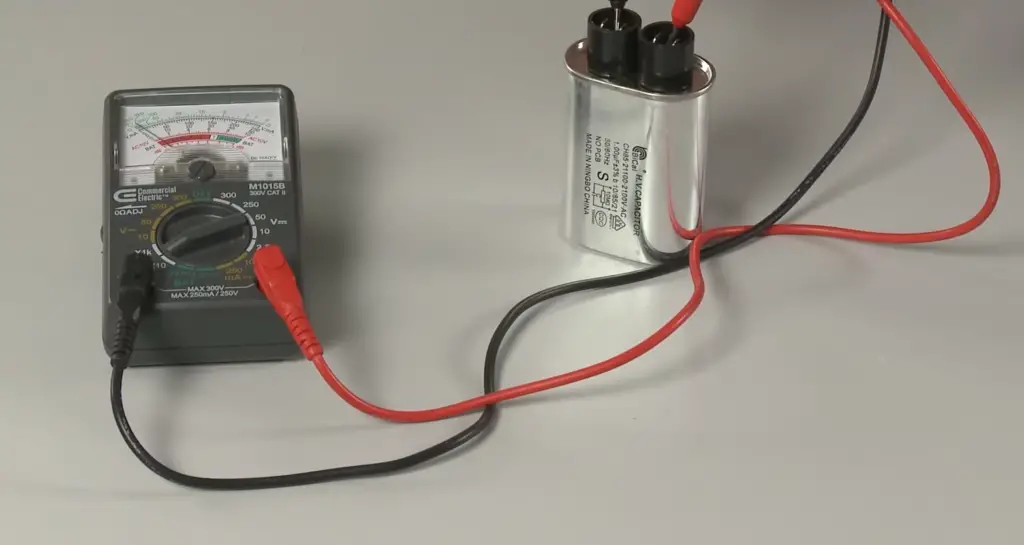
How Long Should You Wait when Changing a Microwave Capacitor?
Discharging the Capacitor
Before changing a microwave capacitor, it is essential to discharge it properly to remove any stored electrical charge. Discharging the capacitor ensures that you won’t be exposed to a potentially dangerous electrical shock during the replacement process. There are various methods to discharge a capacitor, such as using a multimeter or a high-value resistor.
Capacitor Discharge Time
The time required for a capacitor to fully discharge can vary depending on several factors, including the capacitor’s size, capacitance value, voltage rating, and internal discharge circuitry. Generally, it is recommended to wait for at least 5 minutes after discharging the capacitor before attempting to change it. This waiting period allows ample time for the stored charge to dissipate and ensures a safer working environment.
Capacitor Safety Precautions
While waiting for the capacitor to discharge, it is crucial to take additional safety precautions. Keep in mind the following guidelines:
- Use appropriate personal protective equipment (PPE) such as insulated gloves and safety glasses to protect yourself from potential electrical hazards;
- Avoid touching any metal parts or terminals of the capacitor, even after discharging it, as there may still be a residual charge;
- Handle the capacitor with care, as it can be delicate and sensitive to physical damage;
Professional Assistance
If you are uncertain about the proper procedures or lack the necessary experience and expertise, it is highly recommended to seek professional assistance. A trained technician or an appliance repair professional will have the knowledge and tools required to safely handle and replace a microwave capacitor.
FAQ:
1. How do you make sure a capacitor is discharged?
To ensure a capacitor is discharged, follow these steps:
- Unplug the device or disconnect the power source;
- Use an appropriate tool, such as an insulated screwdriver or discharge probe, to short the terminals of the capacitor together;
- Hold the tool in place for a few seconds to allow the charge to dissipate;
- Use a multimeter to verify that there is no voltage remaining across the capacitor terminals;
- Always handle capacitors with caution, even after discharging, as they can store a residual charge;
2. Can a microwave capacitor kill you?
Yes, a microwave capacitor has the potential to deliver a lethal electric shock if mishandled. Capacitors store a significant amount of electrical energy even after the power is disconnected. It is crucial to follow proper safety procedures and discharge the capacitor before working on or near it.
3. How long do microwave capacitors hold charge?
The duration for which microwave capacitors hold a charge can vary. It depends on factors such as the capacitor’s size, capacitance value, voltage rating, and discharge circuitry. Generally, microwave capacitors can hold a charge for a few minutes to several hours [7]. However, it is essential to discharge the capacitor before working on it, regardless of the expected charge retention time.
4. How to test a microwave capacitor with a digital multimeter?
To test a microwave capacitor with a digital multimeter, follow these steps:
- Ensure the capacitor is discharged before testing;
- Set the multimeter to the capacitance mode;
- Connect the multimeter leads to the terminals of the capacitor, observing the polarity;
- The multimeter will display the capacitance value of the capacitor;
- Compare the measured capacitance with the capacitor’s specified value to determine if it is within an acceptable range;
5. How to test a microwave capacitor with a multimeter?
The process of testing a microwave capacitor with a multimeter is similar to testing with a digital multimeter. Set the multimeter to the appropriate mode for measuring capacitance, follow the same steps as mentioned above, and compare the measured capacitance with the specified value.
6. What happens if you don’t discharge a capacitor?
If you don’t discharge a capacitor before working on it or coming into contact with its terminals, it can still retain a charge and pose a risk of electric shock. Accidental contact with a charged capacitor can result in severe injury or even be fatal. Discharging the capacitor is necessary to ensure a safe working environment.
7. How do you know it’s time to replace your capacitor?
Signs that it may be time to replace a capacitor include:
- Physical damage or bulging of the capacitor;
- Leakage or electrolyte spillage;
- Decreased capacitance or failure to hold a charge;
- Excessive heating of the capacitor during operation;
- Malfunctioning of the equipment or irregularities in performance;
If you notice any of these signs or suspect a faulty capacitor, it is advisable to consult a professional or replace the capacitor following appropriate procedures.
8. Will a capacitor discharge on its own?
Capacitors can discharge on their own over time due to internal leakage currents. However, the time it takes for a capacitor to discharge completely on its own can vary depending on the capacitor’s characteristics and the surrounding conditions. To ensure safety, it is recommended to discharge the capacitor using appropriate methods before working on it.
9. How long does it take for a capacitor to dissipate?
The time it takes for a capacitor to dissipate depends on various factors, including the capacitance value, voltage rating, internal leakage, and discharge circuitry. Capacitors can take anywhere from a few seconds to several minutes to dissipate their charge completely. However, it is essential to follow proper discharge procedures and verify with a multimeter before assuming the capacitor is fully discharged.
10. How to discharge a microwave capacitor safely?
To discharge a microwave capacitor safely, follow these steps:
- Unplug the microwave or disconnect the power source;
- Use an insulated screwdriver or a discharge probe specifically designed for capacitors;
- With one hand holding the insulated handle of the tool, touch the metal shaft of the screwdriver or the tip of the discharge probe to both terminals of the capacitor simultaneously;
- Hold the tool in place for a few seconds to allow the charge to dissipate;
Verify with a multimeter that there is no voltage remaining across the capacitor terminals before proceeding with any work.
11. Does discharging a capacitor with a screwdriver damage it?
Discharging a capacitor with a screwdriver, as long as it is done correctly using an insulated screwdriver, should not damage the capacitor. It is important to use proper safety precautions and ensure the screwdriver’s handle is made of insulating material to avoid electric shock. However, care should be taken not to apply excessive force or cause physical damage to the capacitor during the discharge process.
12. How long does it take for a microwave capacitor to discharge itself?
The time it takes for a microwave capacitor to discharge itself can vary depending on factors such as the capacitance value, voltage rating, and discharge circuitry. Generally, microwave capacitors can take anywhere from a few minutes to several hours to discharge themselves completely. It is essential to discharge the capacitor manually using appropriate methods rather than relying solely on self-discharge.
13. How much time does it take to discharge a capacitor?
The time it takes to discharge a capacitor depends on several factors, including the capacitance value, voltage rating, and the method used for discharging. In general, a few seconds to a couple of minutes is typically sufficient to discharge a capacitor. However, it is essential to verify with a multimeter that the voltage across the capacitor terminals is zero before assuming it is fully discharged.
14. Do you need to discharge the microwave capacitor?
Yes, it is crucial to discharge the microwave capacitor before working on it or coming into contact with its terminals. Microwave capacitors can retain a charge even after the power is disconnected, posing a risk of electric shock. Discharging the capacitor ensures a safe working environment.
15. How much voltage is in a microwave capacitor?
Microwave capacitors typically operate at high voltages to support the operation of the microwave. The voltage in a microwave capacitor can range from several hundred to a few thousand volts, depending on the specific microwave model. It is important to handle capacitors with caution and assume they may still hold a charge even after discharging.
16. How do I know if my microwave capacitor is working?
To determine if a microwave capacitor is working, you can perform various tests using a multimeter, such as testing for continuity, capacitance, and leakage. If the capacitor exhibits the expected values within acceptable ranges during these tests, it is likely functioning correctly. However, if the values are significantly different from the specified ranges, it may indicate a faulty capacitor that needs replacement.
17. What size resistor do I need to discharge a microwave capacitor?
To discharge a microwave capacitor using a resistor, a high-value resistor should be used. A resistor with a value of around 10,000 to 100,000 ohms (10kΩ to 100kΩ) or higher is commonly used for this purpose. The resistor acts as a load to slowly dissipate the charge stored in the capacitor. Ensure the resistor is rated for the voltage and power requirements of the specific capacitor being discharged.
18. Can a capacitor charge and discharge instantly?
No, capacitors cannot charge and discharge instantly. Charging and discharging a capacitor require a finite amount of time. The time it takes for a capacitor to charge or discharge depends on the circuit’s characteristics, including the resistance and capacitance values, as well as the applied voltage or current.
19. What is the fastest discharging capacitor?
The speed at which a capacitor discharges depends on its characteristics and the circuit it is connected to. There is no single “fastest discharging capacitor” as it can vary depending on the specific capacitor’s design and the associated circuitry. However, capacitors designed for fast discharging applications, such as supercapacitors or ultracapacitors, are known for their ability to discharge rapidly.
20. Can a capacitor discharge while charging?
No, a capacitor cannot discharge while it is actively charging. Charging and discharging are separate processes that occur sequentially. When a capacitor is being charged, the energy is stored in the dielectric material between the capacitor’s plates. It can only discharge after the charging process is complete or when a discharge path is provided.
21. What happens if you touch a microwave capacitor?
Capacitors store electrical energy and can deliver a high voltage shock even after the power is disconnected. The electrical current passing through the body can cause severe injuries or be fatal. Always assume that a capacitor may still be charged and take proper safety precautions when working with or near it.
22. Are microwave capacitors AC or DC?
Microwave capacitors are typically used in circuits that operate with alternating current (AC). They are designed to handle the voltage and current characteristics of AC power sources commonly used in household appliances like microwaves. However, it is important to note that some microwave circuitry may also include components that rectify AC to DC for specific functions.
23. Why does a microwave need a capacitor?
Microwaves require capacitors for several reasons:
- Power Regulation: Capacitors help regulate the power supply by smoothing out voltage fluctuations and providing stable power to the microwave’s components;
- Energy Storage: Capacitors store electrical energy to provide instantaneous power when required, such as during high-demand operations like heating or cooking;
- Filtering: Capacitors help filter out unwanted noise or interference from the power supply, ensuring a cleaner and more reliable operation;
24. Can I replace a microwave capacitor with a higher UF?
It is generally recommended to replace a microwave capacitor with a capacitor of the same or similar specifications as the original one. The capacitance value, voltage rating, and other characteristics of the replacement capacitor should match or closely match the specifications of the original capacitor. Substituting with a capacitor of higher capacitance (UF) than specified can affect the operation of the microwave and potentially damage other components.
25. Can I use a light bulb to discharge a capacitor?
Using a light bulb as a discharge tool for a capacitor is not recommended. Light bulbs are not designed or suitable for discharging capacitors. It is safer and more effective to use proper tools such as insulated screwdrivers or discharge probes specifically designed for capacitors to ensure a controlled and safe discharge process.
26. How much power is in a microwave’s high voltage capacitor?
The power stored in a microwave’s high voltage capacitor can be calculated using the formula P = 0.5 x C x V^2, where P represents power in watts, C represents capacitance in farads, and V represents voltage in volts. However, it is important to note that the power stored in the capacitor represents the maximum potential energy it can deliver, but not the continuous power consumption of the microwave.
27. Can a microwave capacitor hurt you?
Yes, a microwave capacitor can hurt or even kill you if mishandled. Capacitors store electrical energy and can deliver a powerful electric shock even after the power is disconnected. It is essential to follow proper safety procedures, discharge the capacitor before working on or near it, and exercise caution when handling capacitors to prevent injury or harm.
Useful Video: How to discharge a high voltage capacitor.
References
- https://thekitcheneye.com/how-to-discharge-a-microwave-capacitor/
- https://www.electronicstalk.org/how-long-does-it-take-for-a-microwave-capacitor-to-discharge/
- https://ars.repair/microwave-repair/how-to-discharge-the-capacitor-on-a-microwave
- https://www.circuitsgallery.com/how-long-does-it-take-a-capacitor-to-discharge
- https://centrihome.com/kitchen/how-long-do-microwave-capacitors-hold-charge/
- https://www.gadgetreview.com/how-to-discharge-a-microwave-capacitor
- https://www.kitchenotic.com/how-to-discharge-a-microwave-capacitor/





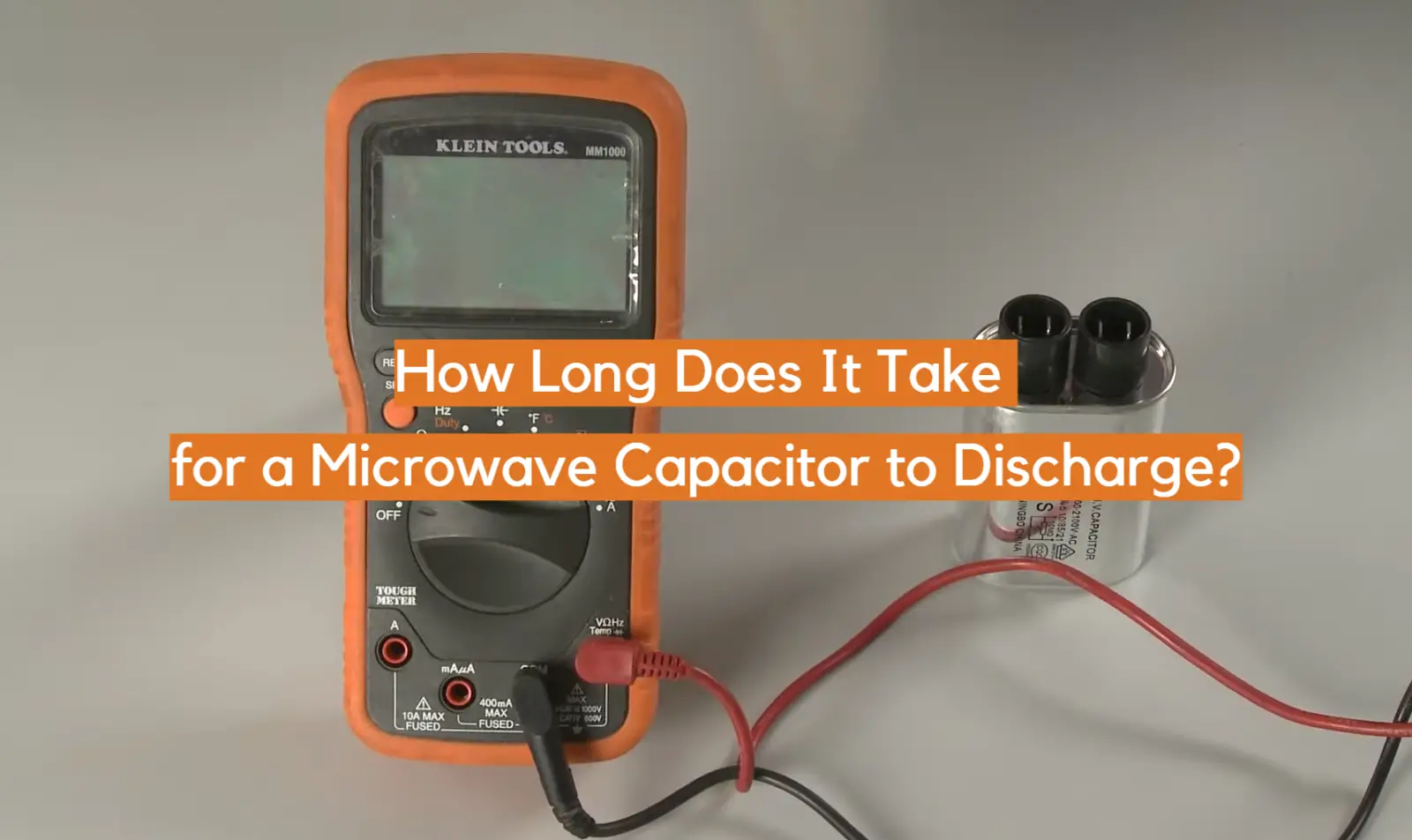








Leave a Reply